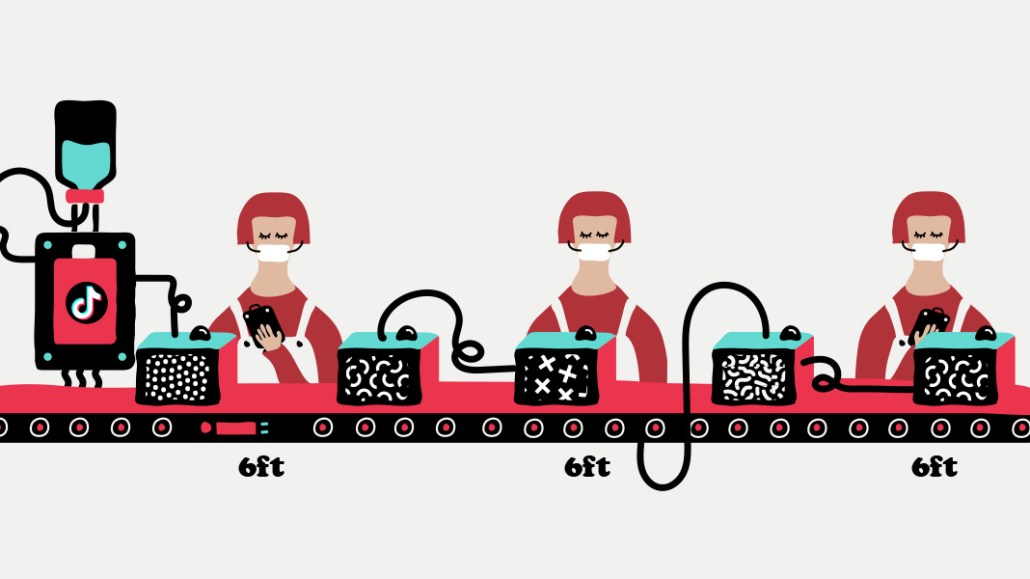Magna research: The do’s and don’ts of native and repurposed advertising on TikTok

It’s hard to dispute that TikTok is currently the hottest social platform given its massive user base is on track to be about 750 million by year’s end, according to eMarketer (TikTok said its base is more like 1 billion).
But there are do’s and don’ts marketers (and the agencies that build and execute their campaigns) must pay close attention to, if they want to break through to the hordes of TikTokers sucked into its algorithmic maw of endless content.
Magna, the research and buying arm of IPG Mediabrands, sought to dig a bit deeper into what resonates, looking specifically at native advertising on TikTok, as well as ads repurposed from broader marketing campaigns on other platforms or media. The study, called “Understanding the Strengths of TikTok Ads,” was shared with Digiday in advance of its public release today.
Working with TikTok’s research team, Kara Manatt, evp and managing director of intelligence solutions at Magna, said the first “hard and fast rule” learned is that any repurposed ad needs to be converted to a vertical presentation, even if it requires redoing the creative.
“There was a huge difference in the performance of the same ad, depending on whether it was vertical or horizontal,” noted Manatt. Vertical ad recall hit 44 percent, whereas horizontal recall was 35 percent. More importantly, the study showed, purchase intent for vertical ads reached 8 percent, while horizontal achieved 3 percent. “That’s a very desirable impact on a metric like purchase intent,” she said.
Manatt pointed out that in many cases, marketers will need to factor verticality into the broader campaign because sometimes converting horizontal ads to vertical made them look “weird,” as she put it.
Generally, native ads performed better because they flowed more organically with TikTok’s user-created or creator-created content, added Manatt. Using beauty and entertainment clients she declined to identify out of client confidentiality, respondents to the survey found native ads “felt more like content,” she said. TikTok did not respond to requests for comment on the study.
Given its appeal to advertisers, how much is too much, even when it comes to native ads on TikTok? After all, Instagram, Facebook and Twitter have gotten heat from their user bases about being overly cluttered with ads.
“There’s been a lot of discourse around how social experiences for users are feeling either really saturated or disrupted by ads,” acknowledged Sadie Miller, svp of social media strategy and partnerships at Magna sibling Reprise. “One of the things TikTok has a step ahead in, is that a lot of the ads that show up on the platform don’t feel like ads off the bat. [For example,] the virality of hashtag challenges — asking users to participate in a brand message — had never been done before. In essence, every participant was part of an ad campaign, even if it didn’t feel that way to them.”
Miller said TikTok’s appeal goes beyond just young audiences, and can help to connect with new audiences. It’s a major part of the consideration when launching social campaigns, having graduated from testing the waters last year.
“A lot of our brands spent 2021 testing it out,” said Miller. “Now we’ve established a great rhythm with brands on how to show up on the platform, which was one of the bigger hurdles” before, when brands used one creative platform to feed multiple social efforts.
Manatt went even further to point out that “anybody who’s really focused on new acquisition should lean into the native format, specifically…Native has the unique ability to cast a wider audience net, because it looks and feels like content. That’s exactly what we found with video completion — that people who have never purchased the brand before who are potential new customers, were more likely to watch the video with native versus repurposed.”
The study’s final learning, as Manatt saw it, was that brands that use TikTok in a native capacity have to prioritize the organic feel of whichever creator they are working through, and focus less on production quality. In other words, authenticity wins. “Brands have a tendency to want to make the creator do this high production thing that doesn’t even fit in with what their norm is right,” she said.
More in Marketing

Best Buy, Lowe’s chief marketing officers explain why they launched new influencer programs
CMOs launched these new programs in response to the growing importance of influencers in recommending products.

Agencies create specialist units to help marketers’ solve for AI search gatekeepers
Wpromote, Kepler and Jellyfish practices aim to illuminate impact of black box LLMs’ understanding of brands search and social efforts.

What AI startup Cluely gets — and ad tech forgets — about attention
Cluely launched a narrative before it launched a tool. And somehow, it’s working.







